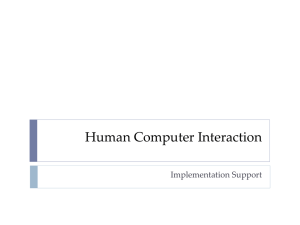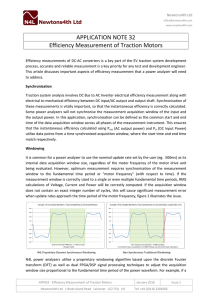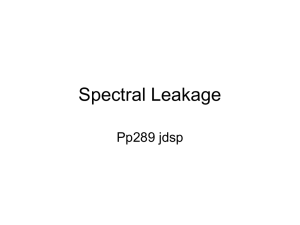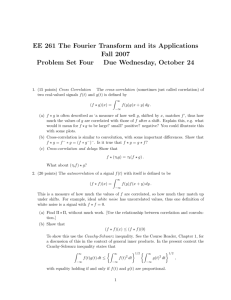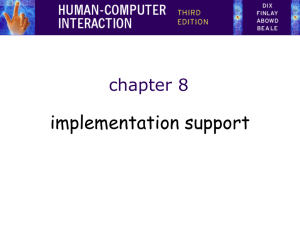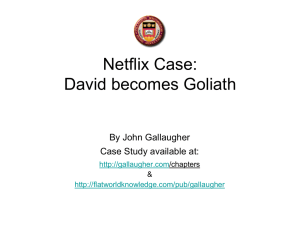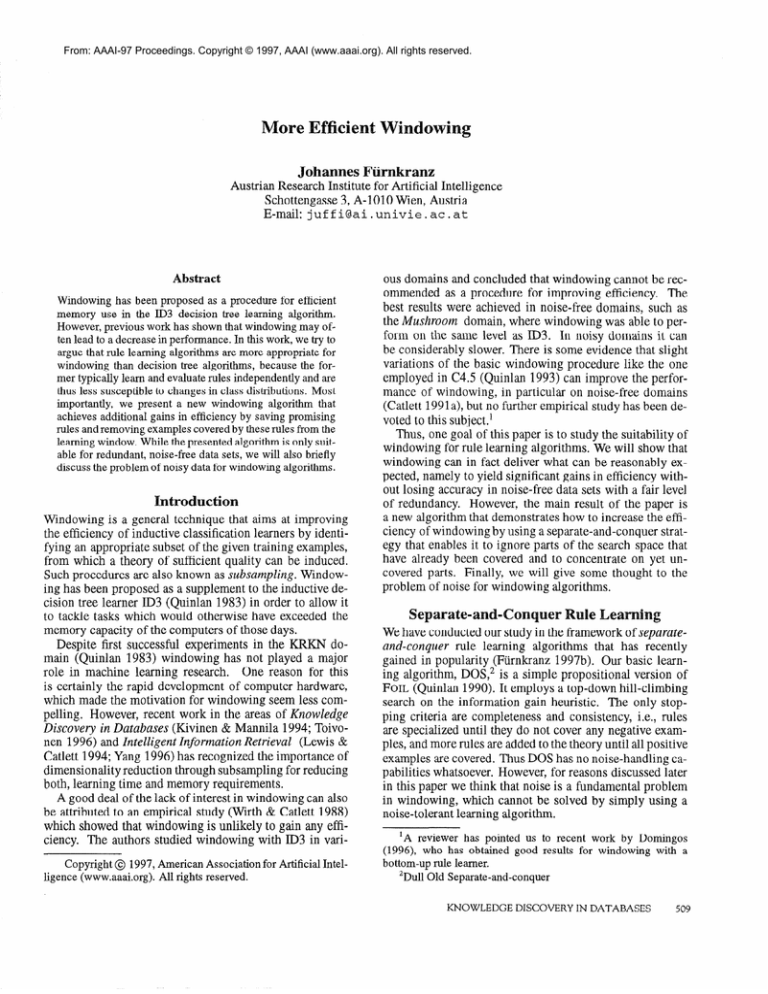
From: AAAI-97 Proceedings. Copyright © 1997, AAAI (www.aaai.org). All rights reserved.
More
Efficient
Windowi
Austrian Research Institute for Artificial Intelligence
Schottengasse 3, A-1010 Wien, Austria
E-mail: juffi@ai.univie.ac.at
Abstract
Windowing has been proposed as a procedure for efficient
memory use in the ID3 decision tree learning algorithm.
However, previous work has shown that windowing may often lead to a decrease in performance. In this work, we try to
argue that rule learning algorithms are more appropriate for
windowing than decision tree algorithms, because the former typically learn and evaluate rules independently and are
thus less susceptible to changes in class distributions. Most
importantly, we present a new windowing algorithm that
achieves additional gains in efficiency by saving promising
rules and removing examples covered by these rules from the
learning window. While the presented algorithm is only suitable for redundant, noise-free data sets, we will also briefly
discuss the problem of noisy data for windowing algorithms.
Introduction
Windowing is a general technique that aims at improving
the efficiency of inductive classification learners by identifying an appropriate subset of the given training examples,
from which a theory of sufficient quality can be induced.
Such procedures are also known as subsampling. Windowing has been proposed as a supplement to the inductive decision tree learner ID3 (Quinlan 1983) in order to allow it
to tackle tasks which would otherwise have exceeded the
memory capacity of the computers of those days.
Despite first successful experiments in the KRKN domain (Quinlan 1983) windowing has not played a major
role in machine learning research.
One reason for this
is certainly the rapid development of computer hardware,
which made the motivation for windowing seem less compelling. However, recent work in the areas of Knowledge
Discovery in Databases (Kivinen & Mannila 1994; Toivonen 1996) and Intelligent Information Retrieval (Lewis &
Catlett 1994; Yang 1996) has recognized the importance of
dimensionality reduction through subsampling for reducing
both, learning time and memory requirements.
A good deal of the lack of interest in windowing can also
be attributed to an empirical study (Wirth & Catlett 1988)
which showed that windowing is unlikely to gain any efficiency. The authors studied windowing with ID3 in variCopyright @ 1997, American Association for Artificial Intelligence (www.aaai.org). All rights reserved.
ous domains and concluded that windowing cannot be recommended as a procedure for improving efficiency. The
best results were achieved in noise-free domains, such as
the Mushroom domain, where windowing was able to perform on the same level as ID3. In noisy domains it can
be considerably slower. There is some evidence that slight
variations of the basic windowing procedure like the one
employed in C4.5 (Quinlan 1993) can improve the performance of windowing, in particular on noise-free domains
(Catlett 1991a), but no further empirical study has been devoted to this subject.’
Thus, one goal of this paper is to study the suitability of
windowing for rule learning algorithms. We will show that
windowing can in fact deliver what can be reasonably expected, namely to yield significant gains in efficiency without losing accuracy in noise-free data sets with a fair level
of redundancy.
However, the main result of the paper is
a new algorithm that demonstrates how to increase the efficiency of windowing by using a separate-and-conquer
strategy that enables it to ignore parts of the search space that
have already been covered and to concentrate on yet uncovered parts. Finally, we will give some thought to the
problem of noise for windowing algorithms.
We have conducted our study in the framework of separateand-conquer rule learning algorithms that has recently
gained in popularity (Fiirnkranz 1997b). Our basic learning algorithm, DOS,2 is a simple propositional version of
FOIL (Quinlan 1990). It employs a top-down hill-climbing
search on the information gain heuristic. The only stopping criteria are completeness and consistency, i.e., rules
are specialized until they do not cover any negative examples, and more rules are added to the theory until all positive
examples are covered. Thus DOS has no noise-handling capabilities whatsoever. However, for reasons discussed later
in this paper we think that noise is a fundamental problem
in windowing, which cannot be solved by simply using a
noise-tolerant learning algorithm.
‘A reviewer has pointed us to recent work by Domingos
(1996), who has obtained good results for windowing with a
bottom-up rule learner.
2Dull Old Separate-and-conquer
KNOWLEDGE DISCOVERY IN DATABASES
509
procedure
WIN-DOS-3.1(Exumples,InitSize,M~?xIncSize)
Train = RANDOMSAMPLE(Examp~es,haitSize)
Test = Examples \ Train
repeat
Theory = DOS(Train)
NewTrain = 0
OldTest = 0
for Example E Test
Test = Test \ Example
if CLASSIPY(Theory,Example) # CLASS(Example)
NewTrain = NewTrain U Example
else
OldTest = OldTest u Example
if INewTrain 1= MaxIncSize
exit for
Test = APPEND(Test,OldTest)
Train = Train U NewTrain
until NewTrain = 8
return(Theory)
Figure 1: Extending
DOS with windowing.
Windowing
Figure 1 depicts the basic windowing algorithm that underlies our implementation,
which follows the description of
(Quinlan 1983). The algorithm starts by picking a random
sample of a user-settable size InitSize from the total set of
Examples. It uses these examples for learning a theory with
a given learning algorithm, in our case the DOS algorithm
briefly described in the previous section. This theory is then
tested on the remaining examples and all examples that are
misclassified by the current theory are removed from the
test set and added to the training set of the next iteration.
In order to keep the size of the training set small, another
parameter, MaxIncSize, controls the maximum number of
examples that can be added to the training set in one iteration. If this number is reached, no further examples are
tested and the next theory is learned from the new training
set. To make sure that all examples are tested in the first
few iterations, our implementation
appends the examples
that have already been tested to the remaining examples in
the test set, so that testing will start with new examples in
the next iteration.
A More Efficient Version of Windowing
One thing that happens frequently when using windowing
with a rule learning algorithm is that good rules have to
be discovered again and again in subsequent iterations of
the windowing procedure. Although correctly learned rules
will add no more examples to the current window, they have
to be re-learned in the next iteration as long as the current
theory is not complete and consistent with the entire training set. We have developed a new version of windowing,
which tries to exploit the property of separate-and-conquer
learning algorithms that regions of the example space which
are already covered by good rules need not be further considered in subsequent iterations.
510
LEARNING
procedure WIN-DOS-95(Examples,InitSize,M&ncSize)
Train = RANDOMSAMPLE(Examples,hitSize)
Test = Examples \ Train
OldTheory = 0
repeat
NewTheory= DOS(Train)
Theory = NewTheory U OldTheory
NewTrain = 8
OldTest = 0
for Example E Test
Test = Test \ Example
if CLAsSlPY(Theory,Example) # CLASS(Example)
NewTrain = NewTrain U Example
else
OldTest = OldTest U Example
i f 1NewTrain 1= MaxIncSize
exit for
Test = APPEND(Test,OldTest)
Train = Train U NewTrain U CovPR(OldTheory)
OldTheory = 0
for Rule E Theory
if CONSISTENT(Rule,NevvTrain)
OldTheory = OldTheory U Rule
Train = Train \ CoVER(Rde)
until NewTruin = 0
return(Theory)
Figure 2: A more efficient version of windowing.
The WIN-DOS-95
algorithms (figure 2) starts just like
WIN-DOS-3.1 : it selects a random subset of the examples,
learns a theory from these examples, and tests it on the remaining examples. However, contrary to WIN-DOS-3.1,
it
does not merely add all examples that have been incorrectly
classified to the window for the next iteration, but also removes all examples that have been classified by consistent
rules from this window. A rule is considered consistent,
when it did not cover a negative example during the testing phase. Note that this does not necessarily mean that
the rule is consistent with all examples in the training set,
as it may contradict a testing example which had not been
tested before MaxIncSize examples were added to the window. Thus apparently consistent rules have to be remembered and tested again in the next iteration. However, we
expect that removing examples that are covered by these
rules from the window should keep the window size small
and thus decrease learning time.
In preliminary experiments it turned out that one problem that happens more frequently in WIN-DOS-95
than in
regular windowing or basic separate-and-conquer
learning
is that of over-specialized rules. Often a consistent rule is
found at a low example size, but other rules are found later
that cover all of the examples this special rule covers. Note
that this problem cannot be removed with a syntactic generality test: consider, for example, the case where a rule
stating that a KRK position is illegal if the two kings are on
the same square is learned from a small set of the data, and
a more general rule is discovered later, which states that all
#Examples
processed
by DOS
Figure 3: Results in the Mushroom domain.
positions are illegal in which the two kings occupy adjacent
squares. Sometimes the examples of the special case can
also be covered by more than one of the other rules. We
have thus developed the following procedure to remove redundant rules: After a theory has been learned, each rule is
tested on the complete training set and rules are ordered according to the number of examples they cover. Starting with
the rule with the least coverage, each rule is tested whether
the examples it covers are also covered by the remaining
rules. If so, the rule is removed. This procedure can be implemented quite efficiently and will only be performed once
at the end of each of the three algorithms.
Experimental
Evaluathn
We have compared both versions of windowing on a variety of noise-free domains. In each domain we ran a series of
experiments with varying training set sizes. For each training set size 10 different subsets of this size were selected
from the entire set of preclassified examples. All three algorithms, DOS, WIN-DOS-3.1,
and WIN-DOS-95
were
run on each of these subsets and the results of the 10 experiments were averaged. For each experiment we measured
the accuracy of the learned theory on the entire example
set, the total run-time of the algorithm,3 and the total number of examples that are processed by the basic learning
algorithm. For DOS, this is of course the size of the respective training set, while for the windowing algorithms
this is the sum of the training set sizes of all iterations of
windowing. All experiments shown below were conducted
with a setting of InitSize = 100 and MaxIncSize = 50. This
setting is briefly discussed in the next section.
Figure 3 shows the accuracy, run-time, and number of
processed examples results for the three algorithms in the
8124 example Mushroom database. WIN-DOS-3.1
seems
to be effective in this domain, at least for higher (> 1000)
training set sizes. Our improved version, WIN-DOS-95,
3Measured in CPU seconds of a microSPARC 110MHz running compiled Allegro Common Lisp code under SUN Unix 4.1.3.
clearly outperforms simple windowing in terms of run-time,
while there are no significant differences in terms of accuracy. WIN-DOS-3.1
needs to submit a total of about
1000 examples to the DOS learner, while WIN-DOS-95
can save about half of them. In a typical run with the above
parameter settings, WIN-DOS-3.1
needs about 4 to 5 iterations, the last of them using a window size of about 200 to
350 examples for learning the correct concept. WIN-DOS95 needs about the same number of iterations, but it rarely
keeps more than 150 examples in its window.
This domain is particularly interesting, because windowing with the decision tree learner ID3 could not achieve significant run-time gains over pure ID3 in a previous study
(figure 2 of (Wirth & Catlett 1988)), while the slightly modifred version of windowing used in C4.5 is able to achieve a
run-time improvement of only about 15% (p. 59 of (Quinlan 1993)). Our results, on the other hand, show that windowing is able to achieve a significant advantage in terms
of run-time at example sizes of about 3000 or higher, where
both windowing algorithms reach a plateau.
We think that the reason for these different results is that
divide-and-conquer
learning as used in ID3 is more sensitive to changes in class distributions in the training examples. The sensitivity of ID3 to such changes is also confirmed by (Quinlan 1993) where it is reported that changing
windowing in a way such that the class distribution in the
initial window is as uniform as possible produces better results.4 In our opinion this sensitivity is caused by the need
of decision tree algorithms to optimize the class distribution
in all successor nodes an interior node. On the other hand,
different class distributions will only have a minor effect
on separate-and-conquer
learners, because they are learning one rule at a time. Adding uncovered positive examples
to the current window will not alter the evaluation of rules
4This equal-frequency subsampling method has first been described in (Breiman et al. 1984) for dynamically drawing a subsample at each node in a decision tree from which the best split
for this node is determined. In C4.5 this technique is used to seed
the initial window.
KNOWLEDGEDISCOVERYIN DATABASES
511
KRKP:
KRKP.
Figure 4: Results in the KRK, KRKN, Tic-Tat-Toe,
that do not cover the new examples, but it may cause the
selection of a new root node in decision tree learning.
Figure 4 shows the results of experiments in four other
noise-free domains in terms of accuracy and run-time.’ The
graphs for the total number of examples processed by DOS,
which we had to omit because of space limitations, were
quite similar to the run-time graphs in all important aspects. The first domain is a propositional version of the
well-known KRK classification task, which is commonly
used as a benchmark for relational learning algorithms. The
target concept is to learn rules for recognizing illegal whiteto-move chess positions with only the white king and rook
and the black king on the board. The propositional version
of this domain consists of 18 binary attributes that encode
the validity or invalidity of relations like adjacent, <,
and = between the coordinates of the three pieces on the
chess board. This task seems to be well-suited for windowing. Predictive accuracy reaches 100% at about 5000 training examples for all three algorithms.
The accuracy differences for lower training set sizes are not significant. At
the sarne size, the run-time of both windowing algorithms
reaches a plateau. The results in the KRKN chess endgame
domain with training set sizes of up to 10,000 examples are
quite similar. However, for smaller training set sizes, which
presumably do not contain enough redundancy, windowing
can take significantly longer than learning from the complete data set. A similar behavior has been observed in the
5We have to apologize for the bad readability of the graphs
of figure 4. Although the curves are hard to discern, we have
decided to leave all of them in the paper, because we think that all
important aspects are clearly visible, and that the identification of
the curves can be inferred from the description in the text.
512
LEARNING
Tert Aceuraey
Train TLme
and KRKP domains.
958 example Tic-Tat-Toe endgame domain.6 Here, predictive accuracy of all three algorithms reaches 100% at about
half the total example set size. Interestingly, WIN-DOS3.1 reaches this point considerably earlier (at about 250 examples). On the other hand, WIN-DOS-3.1
is not able to
achieve an advantage over DOS in terms of run-time, although it is obvious that it would overtake DOS at slightly
larger training set sizes. WIN-DOS-95
reaches this breakeven point much earlier and continues to build up a significant gain in run-time at larger training set sizes. Thus in all
domains discussed so far, WIN-DOS-95
is able to achieve
significant run-time gains by avoiding to re-learn good rules
that have already been discovered in earlier iterations.
In all domains considered so far, removing a few randomly chosen examples from the larger training set sizes
did not affect the learned theories. Intuitively, we would
call such a training set redundant. In the 3196 example
KRKP data set, on the other hand, the algorithms were not
able to learn theories that are 100% correct when tested on
the complete data set unless they use the entire data set for
training. We would call such a data set non-redundant, as
it seems to be the case that randomly removing only a few
examples will already affect the learned theories. In this
domain, WIN-DOS-3.1
processes about twice as many examples as DOS for each training set size. Our improved
version of windowing, on the other hand, processes only
a few more examples than DOS at lower sizes, but seems
to be able to exploit some redundancies of the domain at
6Note that this example set is only a subset of the Tic-Tat-Toe
data set that has been studied in (Wirth & Catlett 1988). We did
not have access to the full data set.
larger training set sizes. The reason for this behavior probably is that even in non-redundant training sets, some parts
of the example space may be redundant, i.e. while removing
randomly chosen examples from the entire example space
will probably affect the learning result, removing randomly
chosen examples from certain regions of the example space
will not affect the result. WIN-DOS-95
exploits this fact
by avoiding to re-learn rules that cover such parts of the
example space.
Parameter Settings
All experiments reported above have been performed with
InitSize = 100 and MaxIncSize = 50. Different variations
of the InitSize parameter have been investigated in (Wirth
& Catlett 1988). Their results indicate that the algorithm
is quite insensitive to this parameter, which we have empirically confirmed. Nevertheless, it might be worthwhile to
use a theoretical analysis of subsampling similar to (Kivinen & Mannila 1994) for determining promising values of
this parameter for a particular domain.
However, we attribute more significance to the choice of
the MaxIncSize parameter, which specifies the maximum
number of examples that can be added to a window. Experiments with different settings of this parameter showed that
in the KRK domain the performance of the algorithms in
terms of run-time and total number of examples needed for
learning is best if this parameter is kept comparably low (10
to 50 examples). In this range, the parameter is relatively
insensitive to its exact setting. If more examples are added
to the window size, performance degrades. For example at
MaxIncSize = 50, WIN-DOS-3
.l performs about 4 iterations of the basic learning algorithm processing a total of
about 700 examples, the final window containing about 250
examples. At MaxIncSize = 1000 on the other hand, the basic learning module not only has to process about twice as
many examples, but windowing also takes more iterations
to converge. Similar behavior can be observed for WINDOS-95.
Thus it seems to be important to continuously
evaluate the learned theories in order to focus the learner
on the parts of the search space that have not yet been correctly learned. This finding contradicts the heuristic that
is currently employed in C4.5, namely to add at least half
of the total misclassified examples. However, this heuristic was formed in order to make windowing more effective
in noisy domains (Quinlan 1993), a goal that in our opinion cannot be achieved with merely using a noise-tolerant
learner inside the windowing loop for reasons discussed in
the next section.
The Problem of Noise in Windowing
An adaptation of the procedures discussed in this paper to
noisy domains is a non-trivial endeavor. We see the major problem with windowing in noisy domains in the fact
that it will eventually incorporate all noisy examples into
the learning window (as they should be misclassified by
the learned rules), but a typical window will only contain a
subset of the original learning examples. Thus the proportion of noisy examples in the learning window will be much
higher than the noise level in the entire data set, which will
make learning considerably harder.
Assume for example that Win-DOS, using a noisetolerant basic inducer, has identified the correct theory from
1000 examples in a 11,000 examples domain, where 10%
of the examples are misclassified due to noise. In the next
iteration, about 1000 noisy examples will be misclassified
by the correct theory and will be added to the window, thus
doubling its size. Assuming that the original window also
contained about 10% noise, more than half of the examples
in the new window are now erroneous, so that the classification of the examples in the new window is in fact mostly
random. It can be assumed that many more examples have
to be added to the window in order to recover the structure that is inherent in the data. This hypothesis is consistent with the results of (Wirth & Catlett 1988) and (Catlett
1991a), where it was shown that windowing is highly sensitive to noise.
A possible approach to solving this problem may lie in
strong assumptions about the noise level in the data, so that
examples are only added to the window if their number exceeds a certain percentage of error on the remaining test
set. However, we then face the problem of deciding which
of the misclassified examples we should add to the window.
Adding all of them (or a random subsample) will again unduely increase the noise level.
We are convinced that our approach, which shows a simple way for integrating a learning algorithm into windowing
instead of only using it as a wrapper, is a first step on the
right track. We believe that the ability of the separate-andconquer strategy to separate regions of the instance space
that have already been sufficiently well explained by some
of the learned rules and to concentrate on covering the remaining portions of the instance space can form the basis
of noise-tolerant windowing procedures. In fact, since the
completion of the draft of this paper, we have been able
to obtain very encouraging results in noisy domains with a
windowing algorithm based on the ideas presented in this
work. Instead of stopping to test a learned theory if enough
exceptions have been found for the next window, the approach we take in (Fiirnkranz 1997a) tests each rule on
the entire remaining data set. This is more costly, but on
the other hand allows to immediately identify rules that are
consistent with the data and to remove all examples they
cover. In order to achieve noise-tolerance,
the algorithm
attempts to recognize “reliable” instead of consistent rules.
There have been several approaches that use subsampling
algorithms that differ from windowing.
For decision tree
algorithms it has been proposed to use dynamic subsampling at each node in order to determine the optimal test.
This idea has been originally proposed, but not evaluated
in (Breiman et al. 1984). Catlett (1991b) has further explored this approach in his work on peepholing, which is a
sophisticated procedure for using subsampling to eliminate
unpromising attributes and thresholds from consideration.
Most closely related to windowing is uncertainty samKNOWLEDGE DISCOVERY IN DATABASES
513
pling (Lewis & Catlett 1994). Here the new window is not
selected on the basis of misclassified examples, but on the
basis of the learner’s confidence in the learned theory. The
examples that are classified with the least confidence will
be added to the training set in the next iteration.
Work on partitioning, i.e. splitting the example space
into segments of equal size and combining therules learned
on each partition, has also produced promising results in
noisy domains, but has substantially decreased learning accuracy in non-noisy domains (Domingos 1996). Besides,
the technique seems to be tailored to a specific learning algorithm and not generally applicable.
Conclusion and Further
We have presented a re-evaluation
for windowing using separate-and-conquer
rule learning algorithms, which
shows that for this type of algorithm significant gains in
efficiency are possible. In particular, we have shown that
separate-and-conquer
algorithms allow a more flexible integration of windowing into thelearning algorithm. However,
the presented results are limited to redundant, noise-free domains. While we believe that the restriction to noise-free
domains can be successfully tackled (Fiirnkranz 1997a), it
lies in the nature of windowing that it can only work successfully, if there is some redundancy in the domain. Methods for characterizing redundant domains are thus a rewarding topic for further research.
Our implementation
currently is limited to 2-class problems and symbolic attributes.
The costs for choosing
thresholds, the standard procedure for handling numerical
data, typically decrease with the number of training examples, which is why we hope that windowing will also
be able to speed up learning in these cases. However, it
is an open question, how the reduced number of possible
thresholds in the learning window affects predictive accuracy. Another assumption made by our algorithm is that
the training examples appear in random order or have been
prerandomized.
Otherwise, the ordering could maliciously
effect the performance of the presented algorithms. Additional gains in efficiency could also be achieved by trying to
specialize over-general rules, instead of entirely removing
them. For this purpose we plan to adapt ideas from research
in theory revision (Wrobel1996).
Acknowledgements
This research is sponsored by the Austrian Fonds zur
Forderung der Wissenschaflichen
Forschung (FWF) under grant number P10489-MAT, Financial support for the
Austrian Research Institute for Artificial Intelligence is provided by the Austrian Federal Ministry of Science and
Transport. I would like to thank Ray Mooney for making
his Common Lisp ML library publicly available, which has
been used for the implementation of our programs; Gerhard
Widmer for his comments on an earlier version of this paper; the maintainers of and contributors to the UC1 machine
learning repository; and the three anonymous reviewers for
valuable suggestions and pointers to relevant literature.
514
LEARNING
eferences
Breiman, L.; Friedman, J.; Olshen, R.; and Stone, C. 1984.
Classi$cation and Regression Trees. Pacific Grove, CA:
Wadsworth & Brooks.
Catlett, J. 1991a. Megainduction:
A test flight. In Birnbaum, L., and Collins, G., eds., Proceedings of the 8th
International Workshop on Machine Learning (ML-91),
596-599. Evanston, IL: Morgan Kaufmann.
Catlett, J. 1991b. Megainduction: Machine Learning on
Very Large Databases. Ph.D. Dissertation, Basser Department of Computer Science, University of Sydney.
Domingos, P. 1996.
duction. In Simoudis,
the 2nd International
ery and Data Mining
Efficient specific-to-general
rule inE., and Han, J., eds., Proceedings of
Conference on Knowledge Discov(KDD-96), 319-322. AAAI Press.
Ftirnkranz, J. 1997a. Noise-tolerant windowing. Technical
Report OEFAI-TR-97-07,
Austrian Research Institute for
Artificial Intelligence. Submitted to IJCAI-97.
Fiirnkranz, J. 1997b. Separate-and-conquer
Arti$cial Intelligence Review. To appear.
rule learning.
Kivinen, J., and Mannila, H. 1994. The power of sampling
in knowledge discovery. In Proceedings of the 13th ACM
SIGACT-SIGMOD-SIGART Symposium on Principles of
Database Systems (PODS-94), 77-85.
Lewis, D. D., and Catlett, J. 1994. Heterogeneous uncertainty sampling for supervised learning. In Proceedings of
the 11th International Conference on Machine Learning
(ML-94). Morgan Kaufmann.
Quinlan, J. R. 1983. Learning efficient classification
procedures and their application to chess end games. In
Michalski, R. S.; Carbonell, J. G.; and Mitchell, T. M.,
eds., Machine Learning. An Artificial Intelligence Approach. Palo Alto, CA: Tioga. 463-482.
Quinlan, J. R. 1990. Learning logical definitions
relations. Machine Learning 5:239-266.
from
Quinlan, J. R. 1993. C4.5: Programs for Machine Learning. San Mateo, CA: Morgan Kaufmann.
Toivonen, H. 1996. Sampling large databases for association rules. In Proceedings of the 22nd Conference on Very
Large Data Bases (VLDB-96), 134-145.
Wirth, J., and Catlett, J. 1988. Experiments on the costs
and benefits of windowing in ID3. In Laird, J., ed., Proceedings of the 5th International Conference on Machine
Learning (ML-?@), 87-99. Ann Arbor, MI: Morgan Kaufmann.
In
Wrobel, S. 1996. First order theory refinement.
De Raedt, L., ed., Advances in Inductive Logic Programming. Amsterdam, Netherlands: 10s Press. 14-33.
Yang, Y. 1996. Sampling strategies and learning efficiency in text categorization.
In Hearst, M., and Hirsh,
H., eds., Proceedings of the AAAI Spring Symposium on
Machine Learning in Information Access, 88-95. AAAI
Press. Technical Report SS-96-05.

